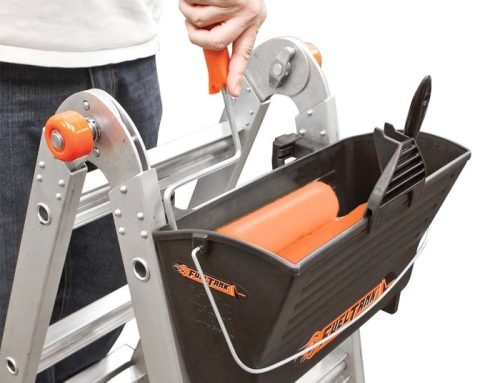Using ladders on roofs is not something to be undertaken lightly, as roof repairs caused by negligent use of a roof ladder can be costly and the effect of a bad accident does not bear thinking about. Using a ladder on a hot tin roof is even more dangerous, as the metal surface gets a lot hotter than conventional roof tiles and tin roofs tend to be less sturdy than other materials.
However, there is one ladder on a hot roof that has been in place for more than 150 years. At the Church of the Holy Sepulchre in Jerusalem, Israel, a wooden ladder was placed on a ledge on the second floor and has not been touched since (apart from an incident in 1997 when a tourist secretly took the ladder and hid it behind the altar – it was found and replaced after a few weeks). The church is shared by six Christian denominations: Greek Orthodox, Roman Catholic, Coptic, Ethiopian and Syriac Orthodox. The church itself is divided into sections, with some being shared between the sects and others belonging strictly to each one. Arguments over access and territory are common.
This contentious situation has been going on for hundreds of years, and one particularly hotly contested area is on a roof, where the Copts and Ethiopians dispute ownership. At least one Coptic monk occupies the roof at any one time, as an expression of their territorial ownership of the site. On a hot day in 2002 one of the monks moved his chair into the shade, a move that was interpreted as a hostile act and invasion of boundaries. 11 people were taken to hospital after the ensuing fight.
With this information it is not hard to see why the ladder (placed on the roof by a person belonging to an unknown sect) has not been moved, as to move it would be seen as a hostile act and would probably incite more violence.
What’s The Best Roof Ladder?
Luckily, most of us are free to move our roof ladders wherever and whenever we wish, but what are the best roof ladders available?
For the professional user, the PROCAT roof ladder system is an excellent choice. Available in initial lengths of 12 to 20 feet in two feet increments, the sectional construction of this system means that a lightweight roof ladder of almost any length is always available. Each model comes in sections of different lengths and extra sections can be bought when more length is needed. Using the right combination of sectional lengths can yield the perfect length roof ladder every time. The main advantage of this system is that the ladder is as light as possible at every point of its length, as there is no doubling up of stiles and rungs as there would be with a conventional extending roof ladder.
The base unit of this roof ladder system is 8 feet long and includes the hook for the roof crest. Extra sections supplied with each model produce the extra length. The ladders weigh between 8 and 14 kilos as standard, so these are very lightweight pieces of equipment. The weight bearing bars as well as the roof hook are covered in rubber for extra grip and the wheels that roll the roof ladder up the slope are rubber covered and rugged for any roof surface. The roof ladder system starts at £126 for the shortest model, to £187 for the longest and the extension sections come in at £36 for 3 feet, £43 for 4 feet and £50 for 6 feet. There is no roof too long for this roof ladder system to cope with!
Lyte Roof Ladders
Another good choice is a roof ladder from Lyte Ladders, a popular name with trade buyers. These are available in single or double extending options. The single roof ladders come in lengths of between 3 and 5.5 metres, with the longest weighing in at 13.5 kilos. Serrated rungs, rubber covered weight bearing bars and solid wheels complete the roof ladder you would expect from Lyte, and with the longest model costing just £124, they are much cheaper than the PROCAT systems of the same length. However, the disadvantage of a single roof ladder over the sectional system is that the roof ladder cannot be folded down for easy transport or storage. If this is not an issue then the Lyte offering is well worth considering.
Built and designed with aerial installation in mind, the Lyte roof ladders are purpose built for jobs that involve long periods on the roof undertaking fiddly tasks, so they feel safe and robust when in use. Their double extending roof ladders only go up to a 4.5 metre model, but the extended length of this ladder is over 7.5 metres (25 feet). A weight of 20 kilos makes it much heavier than the PROCAT alternative, but the cost of £165 cannot compare with the cost of building a roof ladder of a similar length out of the PROCAT system.
If the need for a roof ladder is fleeting, then for as little as £28.50 you can turn an existing ladder into a roof ladder. A Universal Roof Hook clamps onto an existing ladder, transforming it into a roof ladder. The lightweight accessory has sturdy wheels on one side and a strong hook on the other side (once it has been screwed together, as it comes packed flat for easy delivery) and allows you to use any ladder as a roof ladder. However, this gadget does not include anything to help spread the weight of the rungs, as dedicated roof ladders do, so extra caution should be taken when climbing these ladders otherwise damage to the roof tiles is likely.
So whatever your budget or requirements, there are roof ladder solutions out there for everyone.






Leave A Comment
You must be logged in to post a comment.